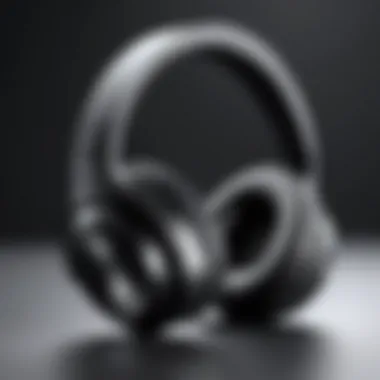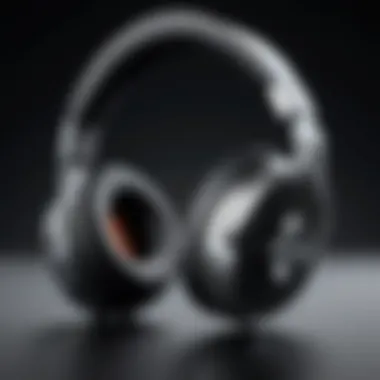Top Studio Monitor Headphones: Your Essential Guide


Intro
In the realm of music production and sound engineering, the choice of studio monitor headphones can significantly influence the quality of work produced. Sound professionals and audiophiles must consider a range of factors when selecting headphones that ensure accuracy and clarity in sound reproduction. This guide aims to unravel the complexities surrounding studio monitor headphones.
From technical specifications to performance metrics, we will cover the essential characteristics that make a headphone suitable for studio use. By analyzing the marketplace, examining various models like the Sennheiser HD 660 S and the Audio-Technica ATH-M50x, and detailing user experience, this comprehensive piece will serve as a foundational resource for those navigating the headphone landscape.
Understanding the importance of these features is pivotal for making informed decisions. Whether it is for critical listening sessions or casual enjoyment, your choice in headphones can either amplify or distort your sound experience.
Let's delve into the hardware specifications that set apart quality headphones from the rest.
Understanding Studio Monitor Headphones
Studio monitor headphones are crucial tools in the realm of audio production. They allow sound engineers and audiophiles to listen to audio with precision. Unlike standard headphones, these are designed for accuracy instead of color or enhancement. This demarcation is vital, as it ensures that what the listener hears reflects the true sound of the material being produced.
For professionals, using studio monitor headphones is about fidelity and reliability. Artists or producers must trust that their headphones will reveal the nuances in sound, allowing for accurate mixing and mastering. The emphasis on neutrality makes it clear why these headphones are favored in professional settings. Without proper equipment, the final product can suffer significantly.
What Defines Studio Monitor Headphones
Studio monitor headphones embody specific characteristics that differentiate them from regular consumer models. Primarily, they focus on a flat frequency response. This ensures that no part of the audio spectrum is exaggerated or diminished. Such hearable neutrality is essential for delivering the most faithful representation of the audio material. Typically, studio monitors have a higher impedance, which allows them to handle professional audio interfaces more effectively.
Moreover, comfort is paramount. Long sessions require headphones that are not only accurate but also comfortable for extended use. This ergonomic aspect can be crucial when adjustments are being made in a mixing environment.
The Role of Impedance in Sound Quality
Impedance plays a significant role in the performance of studio monitor headphones. Measured in Ohms, it affects how much power is required for optimal performance. Low-impedance headphones are easier to drive with portable devices, making them convenient for general use. Higher-impedance models, however, can provide better audio quality but require more power. They are often preferred in studio settings where equipment can deliver the necessary power.
Choosing the correct impedance can drastically influence the overall sound quality and clarity. A mismatch in impedance can also result in lower volume levels or distorted sound, which can undermine the mixing process.
Frequency Response and Its Importance
Frequency response refers to the range of sound frequencies a headphone can reproduce. This measurement is typically expressed in Hertz (Hz). A wide frequency response indicates that the headphone can replicate more of the audio spectrum, from low bass tones to high treble frequencies.
For studio monitor headphones, a flat frequency response curve is typically desirable. This means that the headphones do not artificially amplify or diminish any frequency range. A headphones capable of reproducing the full spectrum without coloration allows sound professionals to identify problems in the mix. Consequently, this characteristic is often a decisive factor when selecting headphones for studio use.
"Inaccurate headphones can lead to flawed mixes that do not translate well across different playback systems."
Understanding these technical aspects of studio monitor headphones sets a solid foundation for sound professionals. It allows informed decisions regarding what equipment aligns with specific needs for audio production.
Key Features to Consider
When selecting studio monitor headphones, several key features greatly influence sound quality and overall user experience. Understanding these features enables professionals and enthusiasts alike to make informed choices, enhancing their auditory capabilities. This section examines comfort and ergonomics, build quality and durability, and the differences between open-back and closed-back headphones. These features are not merely preferences; they play a vital role in defining how headphones perform in various settings.
Comfort and Ergonomics
Comfort is crucial for any headphones, particularly for studio monitor use. Long sessions of mixing or tracking can be demanding on the ears and head. Headphones that are well-designed ergonomically reduce pressure points, allowing for hours of wear without discomfort. The cushioning on the ear pads and headband significantly contributes to this aspect.
- Material Quality: Soft leather or velour are popular materials that provide extra comfort.
- Weight: Lightweight headphones reduce fatigue during long sessions.
- Adjustability: Adjustable sections ensure a snug yet comfortable fit.
Inadequate comfort can distract from critical listening, leading to mistakes in mixing or sound editing. Therefore, testing how a headphone feels during prolonged use is fundamental in the selection process.


Build Quality and Durability
Durability directly relates to how well headphones can endure regular use, especially in studio environments. Good build quality should be a priority for sound professionals who rely on their gear daily. Headphones investing in sturdy materials and thoughtful design offer longevity.
- Types of Materials: Look for metal frames, reinforced cables, and high-quality plastic. These elements prevent breakage from daily wear.
- Replaceable Parts: Some models offer replaceable ear pads and cables, extending the headphones' lifespan.
- Warranty: A robust warranty period often indicates the manufacturer's confidence in the product's durability.
These factors not only ensure your headphones withstand the rigors of studio life but also affect the overall sound reproduction quality over time.
Type of Headphones: Open-Back vs Closed-Back
Choosing between open-back and closed-back headphones is critical as each type serves different purposes. The distinction goes beyond preference; it influences how sound travels and is perceived by the user.
- Open-Back Headphones: These have perforated ear cups. They allow sound to escape, resulting in a more natural sound stage with greater spatial awareness. They offer a sense of 'being there' with the music but may not be suitable for noisy environments.
- Closed-Back Headphones: These headphones have a closed design which provides excellent noise isolation. They are apt for tracking or working in environments with distractions. The sound tends to be more direct, isolating users from external noise without any sound leakage.
- Pros: Better soundstage, improved airflow, comfortable for long wear.
- Cons: Lesser isolation of ambient noise, sound leakage.
- Pros: Superior noise isolation, minimal sound leakage, well-suited for loud environments.
- Cons: Can feel claustrophobic, less spatial awareness.
"The choice between open-back and closed-back headphones can significantly alter your listening experience. Evaluate your specific environment to select the best option."
Making the right choice can enhance both comfort and sound quality, critical for anyone aiming to produce high-quality audio. Specialists and audiophiles should weigh these features correctly to ensure they select headphones suited to their particular needs. Understanding these aspects is essential for effective sound representation.
Analysing Popular Studio Monitor Headphone Models
In the world of audio production, the choice of headphones is paramount. Analysing popular studio monitor headphone models not only informs users of available options, but it also highlights the variances in quality and performance among brands. This section is essential as it equips readers with knowledge on the strengths and weaknesses of different models, ultimately guiding them towards a well-informed purchasing decision. Knowing what is out there makes for more confident choices, tailored to the user's specific needs.
Reviews of Leading Brands
Audio-Technica
Audio-Technica is a prominent name in the world of studio monitor headphones. Their models, particularly the ATH-M50x, are lauded for their excellent sound fidelity and well-balanced audio reproduction. This brand's headphones often feature a closed-back design, which minimizes sound leakage and provides a more immersive listening experience. One key characteristic that sets Audio-Technica apart is the usable frequency range, typically extending from 15Hz to 28kHz, making them popular among sound professionals who need precision.
A unique feature of Audio-Technica headphones is their reversible earcups, enabling a single-ear monitoring mode. This can be advantageous during live sessions or DJing. However, some users report that prolonged use can be uncomfortable, which is a consideration for those planning extended sessions.
Focal
Focal is another distinguished brand, known especially for high-end offerings. The Focal Clear series is celebrated for its remarkable clarity and depth. A key characteristic of Focal headphones is their open-back design, which allows for natural sound flow. This makes them a favored choice for accurate sound representation.
A distinctive aspect of Focal’s design is the aluminum-magnesium dome used in the driver. This provides an impressive response in the mid and high frequencies. However, the open-back design does come with the downside of leaking sound, which might not be suitable in all environments.
Sennheiser
Sennheiser has built a reputation for quality and durability, especially with their HD series. The Sennheiser HD 600, for instance, offers a natural and neutral sound profile that appeals to audiophiles and sound engineers alike. Their headphones are typically lightweight and comfortable, allowing for hours of usage without fatigue.
The dynamic driver technology that Sennheiser employs provides an exceptional bass response without overshadowing other frequencies. On the downside, the price point can be on the higher end, which may deter entry-level buyers.
Beyerdynamic
Beyerdynamic is a well-respected brand that focuses on delivering great sound quality. Their DT 770 Pro model is particularly popular in the studio community. Beyerdynamic headphones feature a closed-back design with a solid bass response. This is essential for many audio applications, as it helps keep unwanted noise out.


One unique aspect of Beyerdynamic headphones is the replaceable parts system, which enhances longevity. Users can easily swap out ear pads or cables when they wear down. The downside is that they can be bulkier compared to other brands, possibly impacting portability.
Comparative Analysis of Features
When choosing studio monitor headphones, understanding the features is crucial. This analysis allows prospective buyers to compare sound quality, comfort, durability, and price effectively. Factors such as frequency response, impedance, and design play a significant role in how a headphone performs in various environments. Evaluating these elements against the specific needs of the user ensures that investments yield satisfying results.
Understanding Sound Accuracy and Representation
Sound accuracy and representation are central to the field of studio monitor headphones. For professionals and audiophiles alike, the ability to hear an uncolored sound is crucial in crafting high-quality music and audio. Accurate sound representation influences decisions made during mixing and mastering, impacting the final output that listeners will receive. This section will elucidate two key elements: neutral sound and the importance of sound stage and imaging.
What is Neutral Sound?
Neutral sound refers to audio that is reproduced without any emphasis on particular frequencies. In essence, it strives for a flat frequency response across the audio spectrum. When headphones deliver a neutral sound, they enable professionals to hear every detail in the mix, ensuring that no element is unnecessarily highlighted or buried.
A defining characteristic of studio monitor headphones is their ability to reproduce music as it was recorded. Achieving this can enhance the mixing process significantly. An engineer can identify problems or imbalances in the track more easily, facilitating a clearer understanding of how the final mix will translate across various playback systems. Brands such as Sennheiser and Focal are often recognized for their commitment to producing headphones that deliver this kind of accuracy.
Benefits of Neutral Sound:
- Enhanced Clarity: Provides a clearer view of how each element interacts in a mix.
- Improved Mixing Decisions: Helps engineers make better choices, ensuring the final product listens well on various systems.
- Realistic Representation: Better facilitates the experience of the actual audio being produced.
The concept of neutrality is vital, enabling artists and engineers to trust what they hear, leading to excellent sound quality in the final product.
Importance of Sound Stage and Imaging
Sound stage and imaging play a significant role in the listening experience. The sound stage refers to the perceived width and depth of the audio environment that headphones create. Imaging, on the other hand, pertains to the accuracy with which sounds are positioned within that environment.
An expansive sound stage allows listeners to distinguish the spatial relationships between various audio elements. This spatial awareness can greatly affect how sound engineers balance a mix. For example, the ability to identify where a vocal lies relative to the instruments provides crucial context, which can guide the mixing process.
In headphones with excellent imaging, sounds can be placed accurately in a three-dimensional space. This quality enables the listener to perceive clarity around different instruments and vocal performances. A headphone model from Audio-Technica, for instance, may excel in producing detailed imaging, which can help professionals in sound positioning.
"Sound stage and imaging capability are crucial for precise audio representation in a studio environment."
Key Considerations for Sound Stage and Imaging:
- Separation of Instruments: A good sound stage allows for distinct hearing separation of instruments.
- Depth and Width: Greater depth adds realism to audio, while width enhances overall spatial properties.
- Positioning Accuracy: Imaging allows for a better grasp of where sounds originate in a track, essential for effective mixing.
Understanding nuance in sound accuracy and representation will aid IT professionals and audiophiles in their quest for superior listening experiences. It guides their choices, ensuring that they invest only in studio monitor headphones that align with these critical factors.
Practical Tips for Selecting Studio Monitor Headphones
Choosing studio monitor headphones can feel overwhelming given the plethora of options. Having practical tips can significantly simplify the selection process and lead to a more informed decision. Whether you are an audio engineer, a music producer, or simply an enthusiast, understanding these guidelines helps align your expectations with performance outcomes. This section emphasizes the necessity of selecting the right headphones tailored to your personal needs and professional requirements.
Assessing Personal Needs and Usage
Before making an investment, it’s crucial to assess your personal needs and intended usage of studio monitor headphones. Different tasks require different capabilities. For example, if your primary use is mixing and mastering, you’ll want headphones that provide a flat frequency response to ensure accurate sound representation. Conversely, if you’re more interested in casual listening or multimedia entertainment, comfort and a broader sonic profile might take precedence.
Moreover, consider the environment where you will be using these headphones. If you are working in a noisy studio, closed-back designs help isolate sound, preventing outside audio from interfering with your sessions. For those creating immersive sound experiences, open-back headphones offer a more natural sound stage but may not suit louder environments.
Take note of your own listening habits. If you plan on wearing the headphones for extended periods, prioritize models known for comfort and ergonomic design. Read reviews regarding comfort and user experiences to gain insights before making a final decision. Doing this groundwork can save potential regrets in the long run.


Budget Considerations for Professionals
Budget considerations form a crucial aspect of the purchasing process. The market offers a wide range of studio monitor headphones at various price points. While high-end models often promise superior sound quality and advanced features, assessing the return on investment is vital. For many professionals, striking a balance between quality and budget can help prevent overspending on capabilities that may not be fully utilized.
When deciding your budget, it’s useful to categorize your needs. Define what you are willing to spend based on your level of commitment. A beginner might find adequate quality in headphones priced below $200, while seasoned professionals with advanced needs may look towards models above $500. Additionally, consider potential future needs. Investing slightly more in a pair of versatile headphones can yield savings over time as you won’t need to replace them as quickly.
"A well-informed choice today can lead to sound investments for years to come."
Another key is to watch for sales or refurbished models from reputable brands. These can provide high-quality options at a reduced price without compromising on performance. Make sure to read through warranties and return policies to ensure you have ample coverage in case the product does not meet expectations.
Caring for Your Studio Monitor Headphones
As audio professionals, understanding how to properly care for your studio monitor headphones is essential. These headphones are not just a tool; they are an investment. Taking time to care for them can significantly prolong their lifespan, ensuring they deliver optimal sound quality for years. This section discusses specific maintenance tips and outlines when it's appropriate to replace your headphones. It provides practical insights that can help users of all levels preserve the quality and functionality of their equipment.
Maintenance Tips for Longevity
Maintaining studio monitor headphones involves a combination of basic practices and considerations. Here are some recommendations:
- Regular Cleaning: Dust and earwax accumulate over time, which can affect sound quality. Use a soft cloth for the exterior and a slightly damp cloth to clean ear cushions. Avoid chemical cleaners unless specified by the manufacturer.
- Safe Storage: When not in use, store headphones in a protective case to prevent damage. Avoid leaving them in direct sunlight or high humidity areas, as these conditions can degrade materials.
- Weekly Inspection: Check cables and connectors frequently for signs of wear, such as fraying or loose connections. This can help prevent any sudden failures during critical times.
- Positioning of Cables: Avoid twisting or pulling the cables during transport. Proper positioning helps in maintaining integrity and avoiding common issues related to wire damage.
Following these simple yet effective maintenance practices can significantly increase the longevity of your headphones, maintaining both performance and sound quality.
When to Replace Your Headphones
Knowing when to replace studio monitor headphones is just as critical as understanding how to care for them. Here are some indicators that suggest it's time for a change:
- Sound Quality Deterioration: If recordings start sounding different or lack clarity, it might indicate the headphones have reached their limit. Any noticeable drop in sound quality should prompt an evaluation.
- Physical Damage: Visible damage to the ear pads, headband, or cables can affect both comfort and sound quality. If repairs are not feasible due to extensive damage, replacement may be necessary.
- Age of Equipment: Most studio monitor headphones can last several years with proper care, but eventually, component wear and tear will require consideration for new gear. Keeping track of the purchase date helps you monitor this aspect more effectively.
"Regular maintenance not only extends the lifespan of studio monitor headphones but also enhances their performance, ensuring that you get the most out of your investment."
Overall, periodic maintenance and awareness of wear indicators ensure that your headphones continue to meet your technical requirements efficiently. Whether you are a seasoned audio engineer or an amateur, understanding these factors can significantly impact your audio experiences.
The Future of Studio Monitor Headphones
The evolution of studio monitor headphones is a vital facet of audio technology that influences how sound professionals and audiophiles experience sound. Understanding the future direction of these headphones is crucial for those invested in quality audio production and consumption. As technology advances, several factors are poised to shape the next generation of studio monitor headphones, including emerging technologies, market trends, and user demands.
Emerging Technologies in Audio
One of the most significant areas of innovation lies in how audio is processed. Manufacturers are increasingly focusing on digital signal processing (DSP) within headphones, which can greatly enhance sound quality and provide customizable sound profiles. This technology allows users to adjust and fine-tune the audio output to suit personal preferences or specific requirements for mixing and mastering.
Additionally, wireless technologies are advancing. While traditional studio monitor headphones have relied on wired connections to ensure high-fidelity audio, wireless models are now adopting lossless audio streaming. Bluetooth manufacturers are optimizing codecs for better sound, minimizing latency, and ensuring a connection that does not compromise audio fidelity.
Active noise cancellation (ANC) has also evolved. High-end studio headphones are now being equipped with sophisticated ANC systems, which can be particularly advantageous for professionals working in noisy environments. This feature allows users to concentrate on their work without the distraction of external sounds.
Furthermore, advancements in hybrid designs are becoming evident. These designs combine elements of open-back and closed-back headphones, potentially offering users the best of both worlds. This trend could cater to a wider audience, appealing to those who crave comfort and sound fidelity during long listening sessions.
Trends and Market Predictions
As the landscape of audio technology shifts, so too do consumer preferences. One notable trend is the growing importance of sustainability in product design. Consumers are increasingly seeking environmentally friendly materials and production processes. Brands that prioritize eco-friendly practices will likely resonate more with this conscious consumer base.
Another trend is personalization. With the rise of digital platforms, users are more inclined to seek headphones that can adapt to their specific listening environments and preferences. Manufacturers may respond by offering more customizable headphone settings or software that allows for deeper interaction with sound profiles.
The market for studio monitor headphones is also seeing a shift towards affordability without compromising professional standards. As technology matures, it is reasonable to expect that entry-level models will adopt features traditionally seen in high-end offerings, widening accessibility for up-and-coming sound professionals.
"The evolution of studio monitor headphones will be closely intertwined with user expectations and technological innovation—those who keep pace with these changes will thrive."



